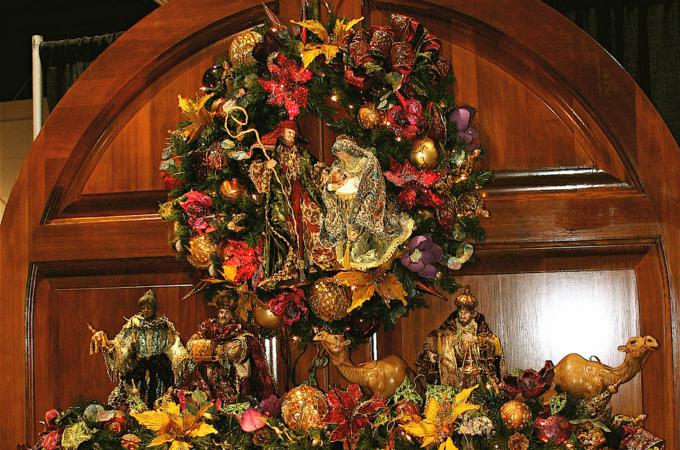'Tis the season for traditions
At a time when tracing your ancestry, delving into your cultural identity, and even testing your DNA are popular, Christians could take a moment this season to look back at their own traditions.
Over the centuries fashion has shaped Christmas. White lights, colored lights, cranberry chains, a crib for the animals, or city sparkling glamour and glitz. There are many choices for how to celebrate the coming of Christ according to our talents and family tastes. If grandma baked yeast bread, called "potecia," rolled with filberts, and raisins, we don't want to lose the recipe or the technique. Europeans, east and west, and north and south, have their own tantalizing recipes for cookies and pastries baked this time of year.
Christmas is truly a magically beautiful time. No wonder Christmas seems to have been appropriated by retailers and the secular world. Santa sells and delights, so we feel compelled to find the right gifts. Over the centuries diverse ethnic cultures have found their own ways to celebrate, in gifts, food and music. The ingredients in these ways vary depending on what is locally available. Cutting down a fir tree is not easy in many lands.
Yet we Catholics want to observe traditional customs which hold meaning for us. For instance, evergreen trees have an entirely medieval origin, well before our notions of English and German trees. Nothing is for naught, so each candle and orb means something. An early practice called the paradise tree was a pyramid of candles representing Christ's ancestors. Then evergreens became a ready fashion as they are considered the symbol of hope.
In Catholic homes the wreath on the front door signals opening the eternal gates through which the King of Glory may enter. Advent wreaths which accompany families' preparation for Christmas may have purple ribbons -- a penitential mood -- replaced by white and gold. Then it is placed on the door as a sign Christ is welcomed in our home and hearts. On Christmas Eve the whole house should be strewn with garlands making ready for the light of the world. One of our mothers was convinced she was the first in suburban New York to add a wreath to the hood of the family car. We have never been able to discover the symbolism of the car.
Early in Advent, the creche has been in place with the hovering Angel Gabriel. The humble stable, with oxen, donkey and nearby shepherds watching their sheep by night, shelters Mary and Joseph as they await the babe who arrives Christmas Eve. Often, we need reminding that he is not yet under the stable roof. The Wise Men likely have been making their journey from foreign lands. A 4th-century fresco from the Domitila catacombs of Rome indicates four kings, though the number varied in artworks until the sixth century when three magi became the standard.
For both Christians and Jews, this is the season of light -- just when it has become so dark. Candles glowed in European homes and squares in the 19th century Christmases. In Spain, children carrying lamps scatter through city streets to light the way for the Three Kings. In Italy, candles were lit to adorn creches in churches, town squares and in fine homes, draped with lemon blossoms and periwinkle. German homes were kept dark so children could be dazzled as they burst into rooms brilliantly lit with candles burning on the tree, and only for a short while, with fire bucket at the ready. The French ceremoniously light the Buch de Noel (yule log) and every window on Paris' great boulevards, as well as ancient stone and modern glass buildings, are outlined with lights. When we arrive for Christmas Eve Mass at our own darkened parish church, we are awed by tall candles and ribbons at the end of each of the pews.
Invite your priests and they will likely recall one of the origins of a Christmas candle in the window, the long and cruel English suppression of the Church in Ireland. Priests, secretly moving from home to home, were hunted like dogs in their heroic efforts to serve the faithful. They stayed in homes with secret hidey-holes. A candle in the window told them it was a safe house. When the English constables questioned the custom, the Irish simply explained they lit candles and kept the door unlocked so Joseph and Mary were welcome if they were looking for an inn. The hope of every Irish family is to have a refugee -- even a distant relative -- come to the celebration of the Mass on Christmas Eve.
Familiar carols and chants are a large part of Christmas. One musical event, "The Messiah," has been performed in Boston by the Handel and Haydn Society annually since 1845. In the 35 or so times we have heard it, the great oratorio "Messiah" lifts a weary world. It happens early in December as we prepare for Advent and Christmas.
Favorite customs can reunite us with our ancestors. Whatever our family origins, we can weave the new fashions with old traditions. In our case, the youngest child present puts the star on the top of the tree. Ornaments have been collected from travels, joined with origami from friends and apples reminding us of our first folk, Adam and Eve. We always place an orange or potato with a dime or nickel in it under the tree. There is no rich sacred meaning to the practice, just a reminder of the Christmas gift one of our fathers recalls from his youth. For his immigrant farming family, he received an orange with a dime stuck in it, if it was a good year; in a poor year, he received a potato with a nickel.
- Kevin and Marilyn Ryan, editors of "Why I'm Still a Catholic," worship at St. Lawrence Church in Brookline, Mass.



















